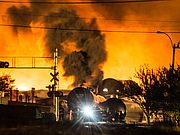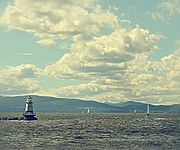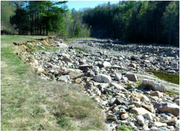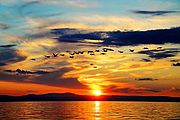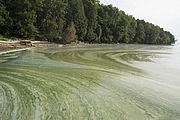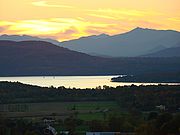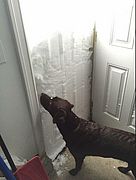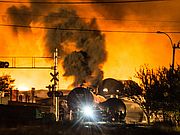Rail transport of explosive Bakken crude oil through the North Country has increased dramatically due to tremendous growth in outputs from Canada and the Bakken oil fields of North Dakota. Rail incidents in Quebec, Alberta, Alabama, North Dakota, New Brunswick, and Virginia have led to fires and explosions. Last year's derailment at Lac-Mégantic, Quebec killed 47 people and devastated the community. Read...
News from Selected Month
Last week EPA held a series of hearings in the Lake Champlain Basin to introduce their proposed phosphorus pollution budget (called a total maximum daily load or TMDL). The budget calls for a 36% reduction in current phosphorus loading to Lake Champlain with watershed specific reductions ranging from a low of 12% in the Isle La Motte section of the lake to a high of 67% in Missisquoi Bay. Read...
Vermont State Agriculture Secretary Chuck Ross issued a ruling that he would not impose best management practices on farmers in northwestern Vermont as a way to improve water quality in Lake Champlain. Read...
The Vermont Agency of Agriculture leveled a $40,000 fine against Leach Farms in Enosburgh Falls for illegal discharge into waters of the state. Workers at the farm flushed out their manure spreader into Bogue Brook, a tributary of the Missisquoi River. Read...
Three years ago Lake Champlain reached record highs and Tropical Storm Irene ravaged the northeast. These and more recent flood events demonstrated the importance of buffers, floodplains, and stable riverbanks and shorelines in reducing sediment and pollution flows to the lake. Read...
Wish you could look at Lake Champlain every day? Now you can with a purchase of LCC's stunning photo cards feature beautiful vistas of our favorite lake! An eight-card set includes two cards each of four different arresting scenes and costs $10 for members, $14 if you haven't joined yet. Read...
This summer marked LCC's tenth year of blue-green algae monitoring and our third year of using a visual approach. We received reports from 87 sites around the lake each week during the summer. During the season LCC volunteers and staff had submitted over 1,165 observations to the blue-green algae tracker, nearly a 40% increase from the previous year. Read...
Over a hundred volunteers trained by LCC filed weekly water quality reports during the summer. Their data provided over 95% of the information on the blue-green algae tracking map housed at the Vermont Department of Health. “The Lake Champlain Committee makes an invaluable contribution to the Lake Champlain Blue-Green Algae Monitoring Partnership,” said Eric Smeltzer, Environmental Scientist with the Vermont Department of Environmental Conservation. Read...
Know someone who loves the lake? Have a good friend who you play on the water with? Express your caring for the wonderful people in your life and your concern for water quality at the same time by gifting a Lake Champlain Committee membership. Read...
Earlier this month lake effect snows dumped over seven FEET of snow around Buffalo, NY. Roads were closed for days; at least 30 roofs collapsed in Erie County; and at the latest toll 13 people had died as a result of the storm, many due to heart attacks caused by trying to move all the snow. Read...
Sea lamprey, best known for their parasitism on salmonids, are among the most primitive organisms with backbones. They belong to a relic group of jawless fish called Agnathans. Their basic body structure evolved much earlier than most other vertebrates. Read...
Are you on Facebook? So are we! 'Like' LCC's Facebook page for engaging content, the latest lake news, and beautiful lake photos. Read...
The U.S. Environmental Protection Agency (EPA) is hosting a series of public meetings this November to outline the next steps in Vermont’s efforts to restore water quality in Lake Champlain. Read...
Rail transport of explosive Bakken crude oil through the North Country has increased dramatically due to tremendous growth in outputs from Canada and the Bakken oil fields of North Dakota. Rail incidents in Quebec, Alberta, Alabama, North Dakota, New Brunswick, and Virginia have led to fires and explosions. Read...

